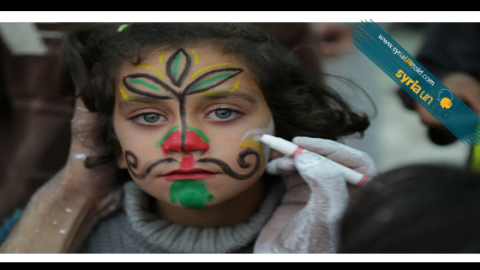It was a fruitious coincidence that brought together activists Razan Ghazzawi, Raed Fares and the rest of the team behind the Bus of Dignity project. The activists, retreating under the brutality of the regime, found a breathing space in the newly-liberated town of Kafranbel, and a welcoming ground for civil society initiatives. Thus was the beginning of their collaboration on the Bus of Dignity.
The initiative provides a creative space that helps motivate the imagination of young children and urges them to express themselves in order to better cope with the changing and traumatic conditions, as of the team members explains in an interview with SyriaUntold.
Nevertheless, this breathing space soon came under another assault. This time not by the regime, but rather the Islamic State of Iraq and Syria (ISIS). The assault set a dangerous precedent as the first of its kind against activities concerned only with the wellbeing of children, as well as escalating ISIS’s war against nonviolent activists in the revolution to new levels.
The Story of the Bus of Dignity
After the regime forces retreated from the countryside of Idlib to concentrate on the city, the activists and local communities in these towns focused on filling the vacuum by providing administrative and public services as well as attempting to rebuild and protect their homes from the regime’s aerial bombardment. A much trickier task also presented itself, especially in the town of Kafranbel, with the arrival of large numbers of the displaced, most of whom were children.
https://www.youtube.com/watch?v=Qao7jKU-o74
The idea for an educational and recreational center specifically for children soon took root, and the project was established on a voluntary basis. The success of the center in its first six months didn’t go unnoticed, and funding was provided to maintain and expand it by other NGOs including Surriyat and War Child International. During this period a myriad of children activities were established at the center including drawing, photography, reading and cartoon screenings, among others.
The team also introduced interactive screening sessions with the children. The sessions included the screening of a short film on the village or town where most of the audience came from. The organizers then would encourage participants to share their own stories and images of the town in an interactive process to bring more depth to the discussions, as well as help heal the open wounds of the refugees in a supportive and safe environment.
All of these activities, according to the organizers, aim at one important goal: “to transform the school from a temporary setting, into a more productive environment that can induce deeper reflections on the crisis, and help relieve the pressures of life as refugee and the traumas of the past through artistic means.
Between the Regime and ISIS
At the time of the ISIS assault on the center, the activists were busy planning an expansion of the project to other towns and villages in Idlib, through training and the creation of mobile venues. But late on the night of December 28, 2013, these plans were shattered as militiamen from ISIS broke into the center and destroyed and confiscated all the materials. The team, which also counts activists Hammoud Juneid, Khaled al-Issa, Firas al-Omar and Hassan al-Ahmad, among its ranks, went into hiding immediately, and received scores of death and detention threats from ISIS, and the center was closed until the town was finally liberated from ISIS a month later.
The activists, all veterans with a long experience of the regime’s brutal tactics, suddenly found themselves trapped again between two sides of the same coin of oppression, the regime and ISIS. A shock that that was magnified further by the casual and brief coverage the assault of ISIS attracted.
Nevertheless, only months later, the team has slowly recovered from that shock. The center remains closed, due to the lack of sufficient materials, but their activities were resumed in a different shape. While the center is being refitted, the team turned its attention to mobile tours of schools in the area, and to recruiting teachers from the refugee population to establish temporary educational centers near their residences.
Like many projects that faced a similar fate, the story of Bus of Dignity and the activists behind it, closely follows the tragic course of Syria’s revolution as a whole. But if the conviction, energy and perseverance of the individuals involved is any indicator, then hope might not be all lost.




